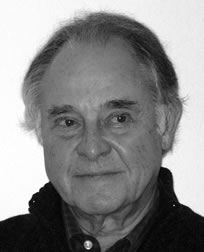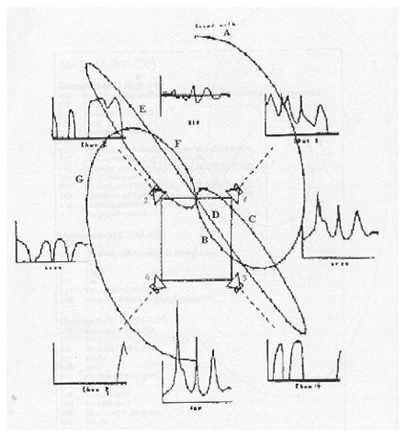Interview with John Chowning
‘Turenas’ and its innovations
John Chowning was born in Salem, NJ in 1934. He studied at Wittenberg University in Ohio, and in Paris with Nadia Boulanger. He received a doctorate in composition from Stanford University in 1966. In 1964, with the help of Max Mathews of Bell Labs and David Poole of Stanford, he set up Music IV using the computer system of Stanford University's AI Lab. Beginning the same year he began the research leading to the first computer sound localization algorithm. In 1967 he discovered FM synthesis, a very simple yet elegant way of creating and controlling time-varying spectra. Licensed by Stanford to Yamaha, FM synthesis led to a family of synthesizers that became the most successful synthesis engines of all time. In 1975 he founded the Center for Computer Research in Music and Acoustics (CCRMA), which remains one of the leading centers for computer music and related research.

Telephone interview from 3 June 1998.
[Bijan Zelli] Mr. Chowning, You were in Europe for some years. Which inspirations in terms of contacts with composers, or getting familiar with new compositions, did you get while you were there for your future works — especially those dealing with spatialization?
[John Chowning] Pieces like Visage by Berio, and well, I guess I heard the premiere of Kontakte. These pieces have certainly been important.
Did you know of any musical composition similar to your Turenas before you started to work on it?
Well, in Kontakte, Stockhausen used fixed microphones and rotating loudspeakers, but I don’t think I know of any work that was done in space where it was more or less a generalization. That would have been difficult to do before computers.
Let’s take a look at Turenas! I have recognized four sections in the piece. 1[1. See the author’s analysis of Turenas in his PhD dissertation, “Reale und virtuelle Räume in der Computermusik: Theorien, Systeme, Analysen.” Kommunikations- und Geschichtswissenschaft, Technische Universität Berlin, 2001.] Does this agree with your compositional structure?
The piece is kind of an arch form, so I think there is another part of section two that is missing. But the thing is, it is not missing in your understanding of the formal structure of the piece, just that what is the tail of the beginning is an expanded development near the end. When I wrote the piece there was a very rapid spiral descent that moved from sort of a metallic sound to a very low kind of wood drum sound near the beginning of the piece. And that is expanded over considerable time before the end, which you have correctly marked as part four. It happens at about 7:45. That whole section that precedes is a development of a very small temporal event that happens maybe at 2:15. At the beginning there are spatial images that prepare for this complicated Lissajous function and that is also a kind of sound trajectory that ends the piece. So it begins soft and far away, comes through and crosses, and then stops in the rear. That’s the opening and closing of the piece. Coming forward after that, in the beginning there is an accelerating canon that goes on and on, and just at the end there is a slow canon of the same pitch set that precedes the trajectory. So what I’m saying is, events of the beginnings and the end are enclosed, sort of nested versions of inner events, which nest some inner events. So it is like an arch form.
What do you think is your main innovation in Turenas?
The point here regarding what I did in the spatial program has to do with a kind of generalization of moving space or moving sound sources through the illusory space. I wrote a paper about it and it explains the program. The program evolved over about two years.
Which music program did you use for producing your sounds?
This is all written in the synthesis program MUSIC IV. The program that I wrote was in Fortran and it was a graphical program. There is a very nice generalization of this program that was done for the Macintosh by Marina Bosi, using pitch bend for Doppler shift.
You have used spatialization in your other pieces too. Could you tell me more about that?
In Sabelithe, the previous piece that I did, I also used moving sound sources. But in that piece I had not finished the program that allowed me to introduce the Doppler shift that could allow sounds to move continuously through the space. So the difference between the spatial use in Sabelith and Turenas was the introduction in Turenas of the Doppler shift. The program had to discretely locate sound. In other words, one could place a sound at a given distance and at a given angle, and I could make that sound move, but I couldn’t make the pitch change as a of function of radial velocity. In Stria I used spatialization too. That was also four channels, however that was not a piece based upon localizing sound sources, but rather creating these big amorphous sound masses or lines of pitches. Because Stria was not based upon an idea that allowed sharp attacks and transients, it would have been difficult to work with localization. So Stria was somewhat different, and I actually modulated the reverberation, but I didn’t think about moving in illusory space.
Could you please explain how this modulation of the reverberation worked in Stria?
Well, that was a very slow modulation, what we called a variable delay, and it caused a very complicated phase interference pattern. I’d say a very, very slow rate of a slow sine modulating delay. Here is the idea: imagine a circular delay, and you’re writing in the samples of the signals at a constant rate in this circle. You’re reading out at a slowly oscillating rate. Sometimes it’s going slightly faster than it is writing. Sometimes it is slightly slower. You’re writing into a storage array at a constant rate and you read out at a certain time later at the rate that varies in time. The form of the variation is sinusoidal, so it is reading ahead a little bit and slows up, and then reads slowly, but the average is the same rate that you’re writing. As you noticed, it was about the reverberation, not the direct signal. The direct signal was not modulated, so that causes a kind of complex interference with the direct signal in each of the four reverberators. Each of the four channels had separate reverberators, and each of those had its own different delay. In those days there was no Doppler shift.
What was the main attraction of using FM-Synthesis in a musical composition for you?
One of the new attributes of frequency modulation synthesis was the possibility of using a very simple synthesis engine. One could change simple parameters like modulation ratio, index, or envelope, and one could touch upon very diverse sorts of centers of timbre, the timbre space. The string-like, the woodwind-like, the brass-like, the percussion… OK, so having this capability within one sort of synthesis algorithm based upon repeating notes, and slowly changing the parameters incrementally or decrementally with each iteration of one of these, one could make timbre changes. For example, starting over your head, the sounds at some point could rapidly change their timbre as they reach closest proximity to the listener.
How about the more stable sounds, those that sound like a chord?
Yes, that is done by changing the tones that have a timbre change in the course of the tone simply by letting modulation index change. The envelope that controls the modulation index slowly changes the number of frequency components which are prominent, and the timbral impression changes. That was the way it was done.
You have coupled timbral transformation with spatial manipulation of the sounds in Turenas. Could you please explain how this worked in the piece?
In Turenas, preceding the part near the end that becomes very loud and pretty percussive and ends with a sudden quiet, there are occurrences of sounds that pass through the space coming from the left and go to the right, or front to the back, and they pass over the listener, as it were. These sounds rapidly change timbre. The timbre is transformed continuously but rapidly. For example, there is a point where it becomes louder and louder, and then as it passes through the space becomes very noisy. In the first part of the piece, where there is a canon that becomes ever faster — that is, an accelerando — that too is gradually changing timbre. What was originally the complex of the beginning and the slow canon all converges to a kind of flute-like timbre at the end.
How much of what you have done in Turenas was experimental?
Turenas was not the first instance of the use of Doppler shift. I did a lot of experiments to develop the technique, and it took me some while because there was a lot that was not known. I think the distance cue in particular was, well, kind of generally known, maybe within the acoustics community. But it was not terribly prominent, so there was no data that I could latch onto easily to build into a computer program. I had to do some number of experiments, and of course in doing experiments one makes a lot of mistakes. For example, I thought: well, I’ll use a kind of source tone that has a sharp attack and exponential envelope. But you can’t hear the reverberation very clearly with that kind of signal because there is no pitch variation. You could hear the repeated attack… but the idea of full reverberation was not apparent because I didn’t know enough. One had to have more complexity in the tone: some inharmonicity, dynamic change in the spectrum, and pitch change of course. One needed all the things that natural tones have, which was not easily done in the early days of computers.
Doppler shift together with Lissajous Figures have played an important role in Turenas. How do they act in the piece?
That’s right. Doppler shift is a powerful cue in illusory motion and it is based on our daily life experience. Near the beginning (but not the very beginning), the first long sustained continuous path of Doppler shift that you hear takes maybe four to five seconds. That one begins at 45 seconds, and it is the one that begins after the sustained low tone comes in. What happens at 0:45 and what happens at 9:45 are kind of similar patterns, although one has a different accompanying tone — the sustained tone underneath. There are other Lissajous patterns in the piece, but they’re not as complicated, and they were really preparatory for this one. This was the first one that was intended to be featured prominently. Other patterns are mostly between the front two channels, but not with an evident Doppler shift.

Does your sound synthesis have any formal function in the piece?
Sure, in the center of this arch form there is a general progression from harmonic tones to inharmonic tones, and by the end the spectrum is composed of harmonic components once again. It is pretty apparent that the canons are composed of tones made of harmonic spectra, and these transformations in the middle become quite inharmonic, with a complicated timbre structure.
Thanks.
Thanks.
Social top